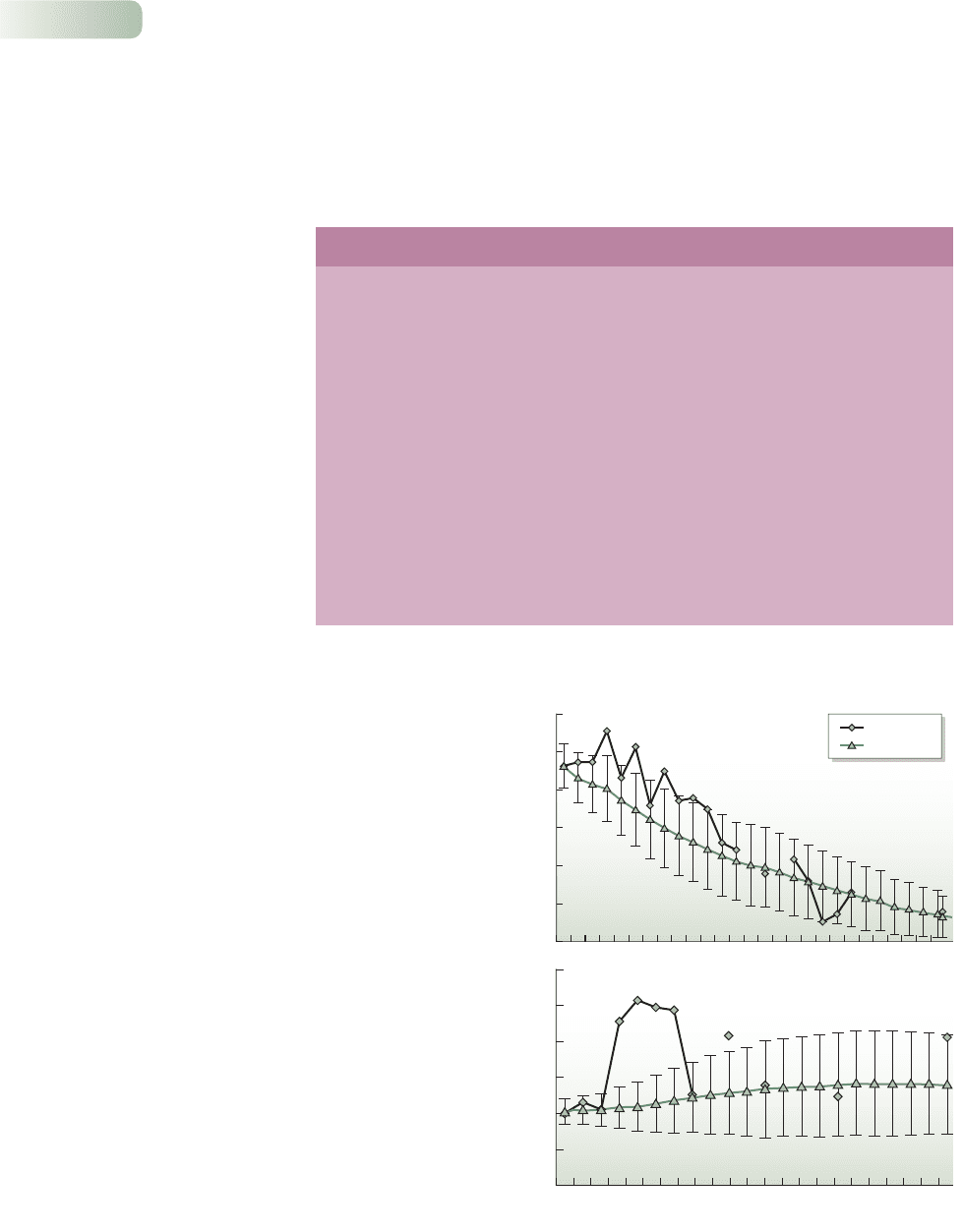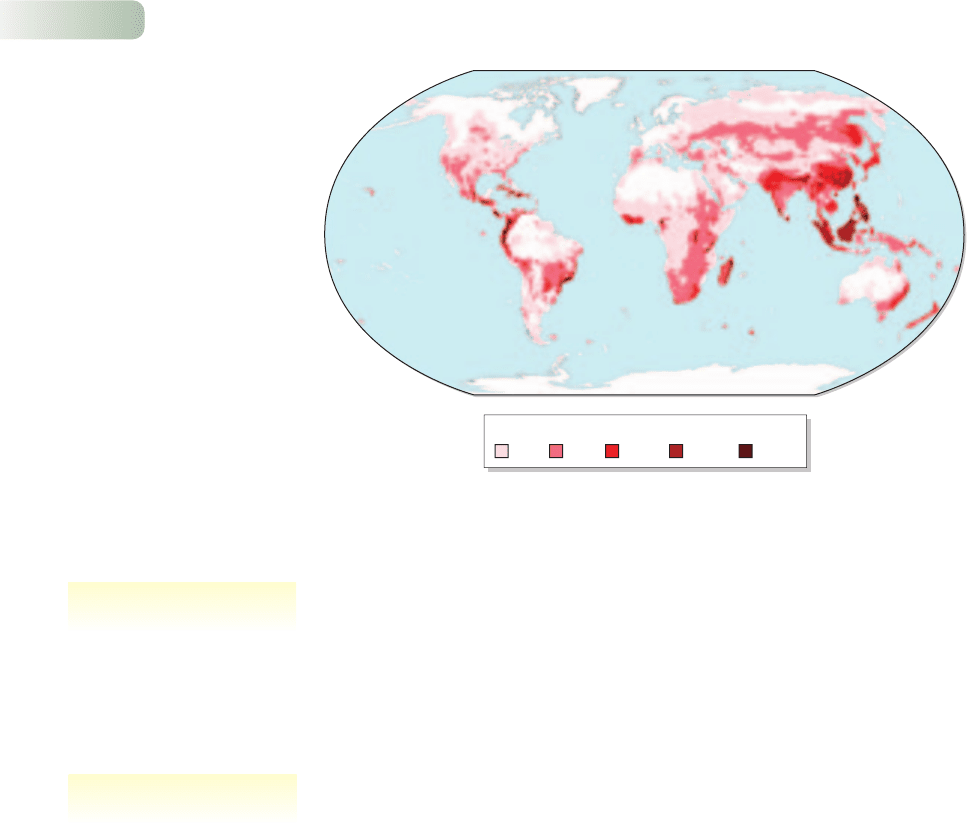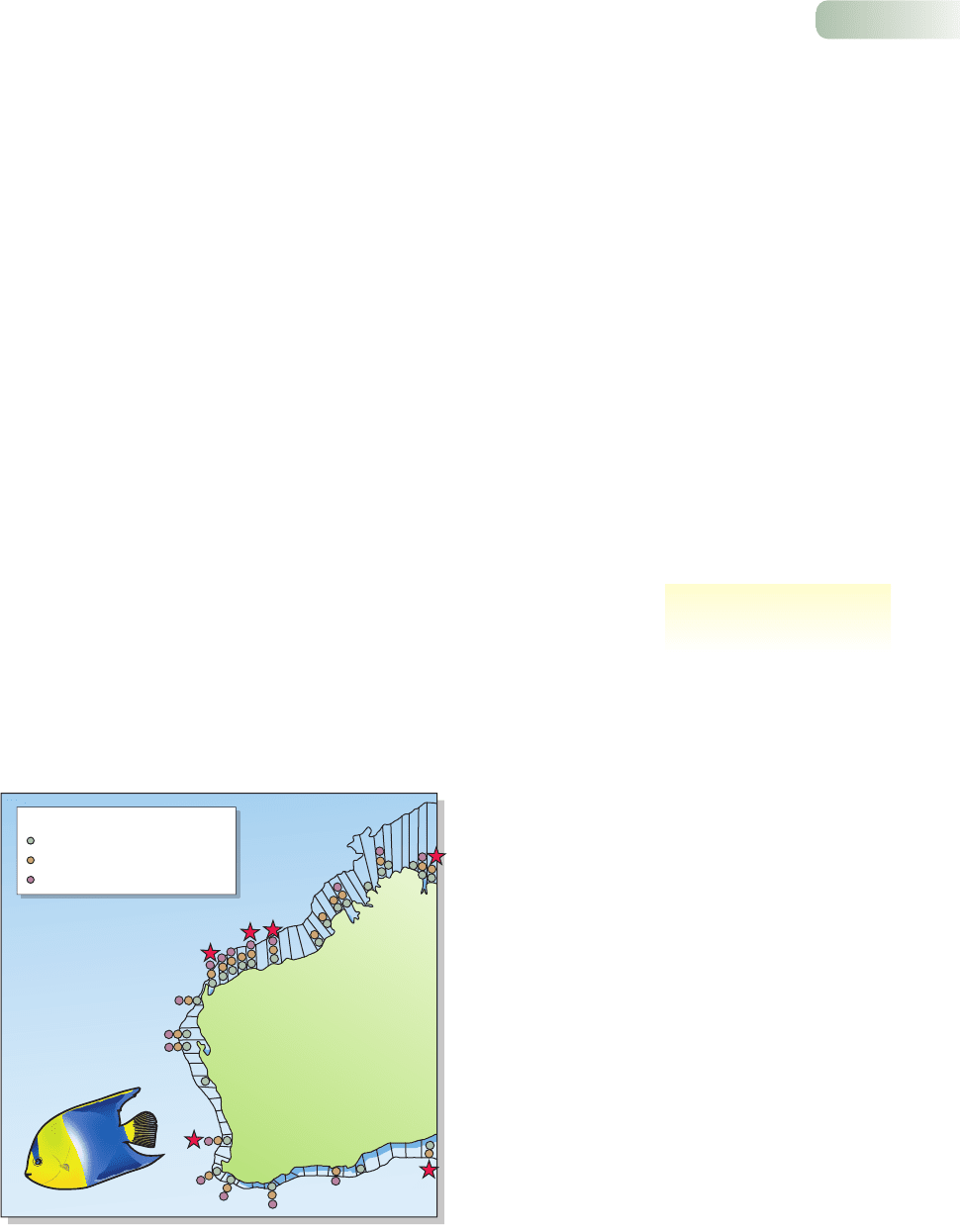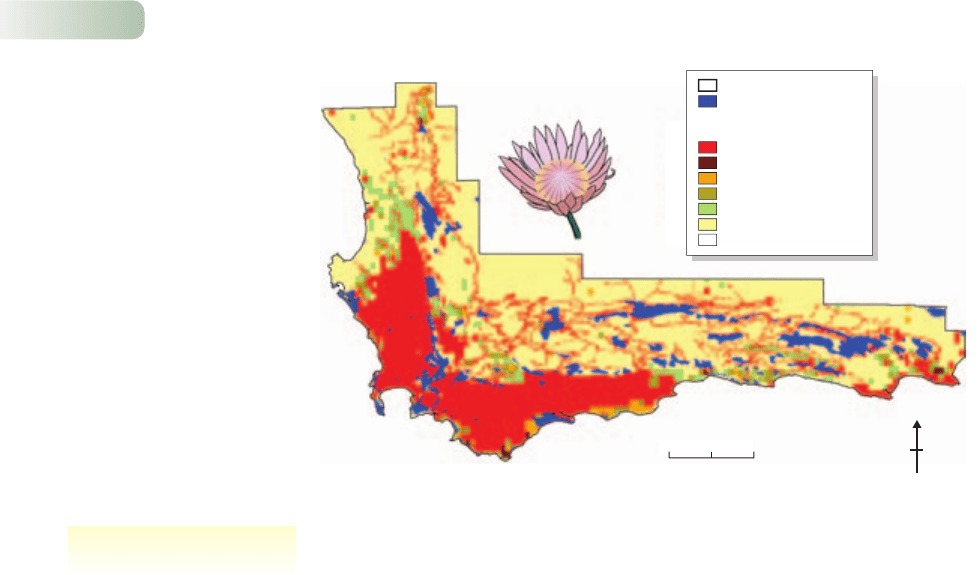Townsend C.R., Begon M., Harper J.L. Essentials of Ecology
Подождите немного. Документ загружается.


14.3.1 Population viability analysis
Data sets such as those for bighorn sheep in desert areas in Figure 14.5b are
unusual because they depend on a long-term commitment (in this case, by hunt-
ing organizations) to monitor a number of populations. If we set an arbitrary
definition of the necessary minimum viable population (MVP) as one that will
give at least a 95% probability of persistence for 100 years, we can explore data
like these to provide an approximate estimate of MVP. Bighorn populations of
fewer than 50 individuals all went extinct within 50 years, while only 50% of
populations of 51–100 sheep lasted for 50 years. Evidently, for an MVP here we
require more than 100 individuals; indeed, for these sheep such populations
demonstrated close to 100% persistence over the maximum period studied of
70 years. The value for conservation of studies like this, however, is limited
because they deal with species that are generally not at risk.
Simulation models known as population viability analyses (PVAs) provide an
alternative, more specific way of gauging viability. Usually, these encapsulate sur-
vivorships and reproductive rates in age-structured populations (see Chapter 5).
Random variations in these elements or in carrying capacity (K) can be employed
to represent the impact of environmental variation, including that of disasters of
specified frequency and intensity. Density dependence can be introduced where
required. In the more sophisticated models, every individual is treated separately
in terms of the probability, with its imposed uncertainty, that it will survive or pro-
duce a certain number of offspring in the current time period. The program is run
many times, each giving a different population trajectory because of the random
elements involved. The outputs, for each set of model parameters used, include
estimates of population size each year and the probability of extinction during the
modeled period (the proportion of simulated populations that go extinct).
Koalas (Phascolarctos cinereus) are regarded as ‘near threatened’ in Australia,
with populations in different parts of the country varying from secure to vulner-
able or extinct. Penn et al. (2000) used a widely available PVA tool (known as
VORTEX; Lacy, 1993) to model two populations in Queensland, one thought to be
declining (Oakey), the other secure (Springsure). Koala breeding commences at
2 years in females and 3 years in males. The other demographic values were derived
from extensive knowledge of the two populations and are shown in Table 14.1.
Note how the Oakey population had somewhat higher female mortality and fewer
females producing young each year. The Oakey population was modeled from 1971
and the Springsure population from 1976 (when first estimates of density were
available) and the model trajectories were indeed declining and stable, respectively
(Figure 14.9). Over the modeled period, the probability of extinction of the Oakey
population was 0.380 (i.e. 380 out of 1000 iterations went extinct) while that for
Springsure was 0.063. Managers concerned with critically endangered species do
not usually have the luxury of monitoring populations to check the accuracy of their
predictions. In contrast, Penn et al. (2000) were able to compare the predictions
of their PVAs with real population trajectories, because the koala populations
have been continuously monitored since the 1970s (Figure 14.9). The predicted
trajectories were close to the actual population trends, particularly for the Oakey
population, and this gives added confidence to the modeling approach. The pre-
dictive accuracy of VORTEX and other simulation modeling tools has also been
shown to be good for 21 other long-term animal data sets (Brook et al., 2000).
Chapter 14 Conservation
469
trying to determine the minimum
viable population
simulation modeling – population
viability analysis
koalas – identifying populations
at particular risk
9781405156585_4_014.qxd 11/5/07 15:05 Page 469

Part IV Applied Issues in Ecology
470
60
50
40
30
20
10
0
1971 73 75 77 79 81 83 85 87 89 91 93 95 97
No. of koalas
Observed
VORTEX
(a)
(b)
1976 80 84 88 92 96
60
50
40
30
20
10
0
No. of koalas
Year
Figure 14.9
Observed koala population trends (diamonds) compared with
predicted population performance (triangles, ± 1 SD) based on
1000 repeats of the VORTEX modeling procedure at (a) Oakey
and (b) Springsure. Real population censuses were not
performed every year.
AFTER PENN ET AL., 2000
Table 14.1
Values used as inputs for simulations of koala populations at Oakey (declining) and Springsure (secure).
Values in brackets are standard deviations due to environmental variation; the model procedure involves
the selection of values at random from the range. Catastrophes are assumed to occur with a certain
probability; in years when the model ‘selects’ a catastrophe, reproduction and survival are reduced
by the multipliers shown (e.g. in a year with a catastrophe, reproduction is reduced to 55% of what it
would otherwise have been).
AFTER PENN ET AL., 2000
VARIABLE OAKEY SPRINGSURE
Maximum age 12 12
Sex ratio (proportion male) 0.575 0.533
Litter size of 0 (%) 57.00 (±17.85) 31.00 (±15.61)
Litter size of 1 (%) 43.00 (±17.85) 69.00 (±15.61)
Female mortality at age 0 32.50 (±3.25) 30.00 (±3.00)
Female mortality at age 1 17.27 (±1.73) 15.94 (±1.59)
Adult female mortality 9.17 (±0.92) 8.47 (±0.85)
Male mortality at age 0 20.00 (±2.00) 20.00 (±2.00)
Male mortality at age 1 22.96 (±2.30) 22.96 (±2.30)
Male mortality at age 2 22.96 (±2.30) 22.96 (±2.30)
Adult male mortality 26.36 (±2.64) 26.36 (±2.64)
Probability of catastrophe 0.05 0.05
Multiplier, for reproduction 0.55 0.55
Multiplier for survival 0.63 0.63
% males in breeding pool 50 50
Initial population size 46 20
Carrying capacity, K 70 (±7) 60 (±6)
9781405156585_4_014.qxd 11/5/07 15:05 Page 470

How can such modeling be put to management use? Local governments in
New South Wales are obliged both to prepare comprehensive koala manage-
ment plans and to ensure that developers survey for potential koala habitat when
a building application affects an area greater than 1 ha. Penn et al. (2000) argue
that PVA modeling can be used to determine whether any effort made to protect
habitat is likely to be rewarded by a viable population.
The life histories of plants present particular challenges for simulation model-
ing, including seed dormancy, highly periodic recruitment of seedlings and clonal
growth (Menges, 2000). However, as with endangered animals, different man-
agement scenarios can be simulated in PVAs. The royal catchfly, Silene regia, is a
long-lived prairie perennial whose range has shrunk dramatically. Menges and
Dolan (1998) collected demographic data for up to 7 years from 16 populations
in the US Midwest. The populations, whose total adult numbers ranged from 45
to 1302, had been subject to different management regimes. This species, whose
seeds do not show dormancy, has high survivorship and frequent flowering,
but successful germination is very episodic – most populations in most years
fail to produce seedlings.
Simulation modeling made use of population projection matrices, which are
particularly useful for analyzing species with overlapping generations. A population
projection matrix acknowledges that most life cycles comprise a sequence of dis-
tinct classes with different rates of fecundity and survival. A matrix for one of the
populations of S. regia is illustrated in Table 14.2. Such matrices were produced for
each population in each year. Multiple simulations, each lasting 1000 years, were
then run for every matrix to determine both the probability of extinction and the
population’s finite rate of increase, λ. This term has not yet been introduced, but
note that it is related to the population’s intrinsic rate of increase, r, discussed in
Box 5.4. In fact, r = ln λ. For now, all you need to appreciate is that a population will
grow in size when λ>1 and will decline when λ<1; a value of λ=2, for example,
means that on average every individual in the population will give rise to two indi-
viduals in the next generation (either by producing one surviving offspring and
staying alive itself, or by dying but producing two surviving offspring).
Figure 14.10 shows the median population growth rate λ for the 16 popula-
tions, grouped into cases where particular management regimes were in place.
Chapter 14 Conservation
471
Table 14.2
An example of a projection matrix (using the simulation modeling tool called RAMAS-STAGE) for a particular Silene regia population from 1990 to
1991, assuming successful germination of seedlings. The numbers represent the proportion changing from the stage in the column to the stage in
the row (bold values represent plants remaining in the same stage). ‘Alive undefined’ represents individuals with no size or flowering data, usually
as a result of mowing or herbivory. The numbers in the top row are seedlings produced by flowering plants. The finite rate of increase, λ, for this
population is 1.67. (Note that a population will increase when λ>1, and decrease when λ<1.) The site is managed by regular burning.
AFTER MENGES & DOLAN, 1998
SMALL MEDIUM LARGE ALIVE
SEEDLING VEGETATIVE FLOWERING FLOWERING FLOWERING UNDEFINED
Seedling – – 5.32 12.74 30.88 –
Vegetative 0.308 0.111 0000
Small flowering 0 0.566 0.506 0.137 0.167 0.367
Medium flowering 0 0.111 0.210 0.608 0.167 0.300
Large flowering 0 0 0.012 0.039 0.667 0.167
Alive undefined 0 0.222 0.198 0.196 0 0.133
the royal catchfly – management
of an endangered plant
9781405156585_4_014.qxd 11/5/07 15:05 Page 471

This was done both for years when recruitment of seedlings occurred and for years
when seedling recruitment did not occur. All sites where λ was greater than 1.35
when recruitment took place are managed by burning and some by mowing as
well; none of these were predicted to go extinct during the modeled period. On
the other hand, populations with no management regime, or whose management
does not include fire, had lower values for λ and all except two had predicted
extinction probabilities (over 1000 years) of from 0.10 to 1.00.
The obvious management recommendation is to use prescribed burning to pro-
vide opportunities for seedling recruitment. Low establishment rates of seedlings
may be due to rodents or ants eating fruits or to competition for light with other
plants – burnt areas probably reduce one or both of these negative effects.
14.3.2 Dealing with genetic issues
The pink pigeon (Columba mayeri), once widespread on the island of Mauritius,
was down to only nine or 10 birds in 1990. As a result of the release of captive-
bred individuals the population had swelled to 355 free-living individuals (plus
more in captivity) by 2003. In captivity, the aim was to manage matings to retain
high levels of genetic diversity and to minimize inbreeding. The captive popula-
tion was originally descended from just 11 founder individuals, augmented in
1989–1994 by adding 12 more founder individuals (offspring of the remaining
wild individuals).
Once captive-reared birds are released into the wild the incidence of inbreed-
ing depression is not easy to control – the tactic of releasing a large number of
birds provides the greatest chance of success. Between 1987 and 1997, 256 birds
were reintroduced on Mauritius – wherever possible selecting birds with minimal
inbreeding (based on records in breeding ‘stud books’) and releasing them in
groups with good representation of the different founder ancestries. All birds
were banded for unique identification.
The genetics and ecological success of both captive and wild populations
have been carefully monitored. Thus, we can evaluate the impact of inbreeding
Part IV Applied Issues in Ecology
472
0.4
0.6
0.8
1.0
1.2
1.4
1.6
1.8
Median value of λ
Fire and mowing Fire
Management regime
No fire
Figure 14.10
Median rates of population increase (λ) of Silene regia populations in
relation to management regime, for years with seedling recruitment
(shaded circles) and without (open triangles). Unburned management
regimes include just mowing, herbicide use or no management. All sites
above the dashed line have values for λ of >1.0, indicating their capacity
to grow in size. Those below the line are on paths to extinction.
AFTER MENGES & DOLAN, 1998
recovery of the pink pigeon
9781405156585_4_014.qxd 11/5/07 15:05 Page 472

on survival and reproduction under the controlled situation of captive rearing
and also in the more risky circumstances of the wild. Inbreeding reduced egg
fertility and survival of nestlings (Figure 14.11), but effects were only strongly
marked in the most inbred birds. The pink pigeon reintroduction success story has
the added benefit of providing a rare quantification of the value of avoiding
inbreeding when managing endangered populations.
14.3.3 Selecting conservation areas
Producing survival plans for individual species may be the best way to deal with
species recognized to be in deep trouble and identified to be of special importance
(e.g. keystone species described in Section 9.5.2, evolutionarily unique species
or charismatic large animals that are easy to ‘sell’ to the public). However, there
is no possibility that all endangered species could be dealt with one at a time.
Conservation dollars are simply too limited for this. We can, though, expect to
conserve the greatest biodiversity if we protect whole communities by setting
aside protected areas. In fact, protected areas of various kinds (national parks,
Chapter 14 Conservation
473
AFTER SWINNERTON ET AL., 2004
1.0
0.8
0.6
0.4
0.2
0
Probability of survival
(a)
(b)
Moderately
inbred
Highly inbred
1.0
0.8
0.6
0.4
0.2
0
0102030
Survival time (days)
Probability of survival
Moderately
inbred
Highly inbred
Non-inbred
Non-inbred
Figure 14.11
Effect of inbreeding on probability of survival to 30 days of age of
pink pigeon nestlings (a) in captivity and (b) in the wild population.
Inbreeding is expressed as an index derived from known ancestry
in relation to 23 founder individuals. The fewer founders in a bird’s
ancestry, the higher the index of inbreeding. Birds are grouped into
three classes – non-inbred, moderately inbred and highly inbred.
Only highly inbred birds show a powerful effect of inbreeding.
9781405156585_4_014.qxd 11/5/07 15:05 Page 473

nature reserves, sites of special scientific interest, etc.) grew both in number and
area during the 20th century. Currently, about 7.9% of the world’s land area is
protected (and 0.5% of the sea area; Balmford et al., 2002).
It is important to devise priorities so that the restricted number of new pro-
tected areas, in terrestrial and marine settings, can be evaluated systematically
and chosen with care. We know that the biotas of different locations vary in
species richness (with particular centers of diversity), the extent to which the
biota is unique (with centers of endemism) and the extent to which the biota
is endangered (with hotspots of extinction, for example because of imminent
habitat destruction). One or more of these criteria could be used to prioritize
potential areas for protection (Figure 14.12).
A perhaps rather surprising application of island biogeography theory (see
Section 10.5.1) is in nature conservation. This is because many conserved areas
and nature reserves are surrounded by an ‘ocean’ of habitat made unsuitable, and
therefore hostile, by people. Can the study of islands in general provide us with
design principles that can be used in the planning of nature reserves? The answer
is a cautious ‘Yes’; some general points can be made.
1 One problem that conservation managers sometimes face is whether to
construct one large reserve or several small ones adding up to the same total
area. If the region is homogeneous in terms of conditions and resources,
it is quite likely that smaller areas will contain a subset of the species
present in a larger area. In such as case it would be preferable to construct
the larger reserve in the expectation of conserving more species in total
(this recommendation derives from the species–area relationships discussed
in Section 10.5.1).
2 On the other hand, if the region as a whole is heterogeneous, then each
of the small reserves may support a different group of species and the
total conserved might exceed that in one large reserve of the same size.
In fact, collections of small islands tend to contain more species than a
comparable area composed of one or a few large islands. The pattern
Part IV Applied Issues in Ecology
474
1–2 3–6 7–12 13–22 23–54
Number of species
Figure 14.12
Distribution of biodiversity hotspots,
showing numbers of species of
globally threatened birds plus
amphibians mapped on an equal area
basis (each grid cell is 3113 km
2
).
AFTER RODRIGUES ET AL., 2006
the design of nature reserves
biodiversity hotspots
9781405156585_4_014.qxd 11/5/07 15:05 Page 474

is similar for habitat islands and, most significantly, for national parks.
Thus, several small parks contained more species than larger ones of
the same area in studies of mammals and birds in East African parks,
of mammals and lizards in Australian reserves, and of large mammals
in national parks in the USA. It seems likely that habitat heterogeneity
is a general feature of considerable importance in determining species
richness.
3 A point of particular significance is that local extinctions are common
events, and so recolonization of habitat fragments is critical for the survival
of fragmented populations. Thus, we need to pay particular attention to the
spatial relationships amongst fragments, including the provision of dispersal
corridors. There are potential disadvantages – for example, corridors could
increase the correlation among fragments of catastrophic effects, such as
the spread of fire or disease – but the arguments in favor are persuasive.
Indeed, high recolonization rates (even if this means conservation managers
themselves moving organisms around) may be indispensable to the success
of conservation of endangered metapopulations. Note especially that human
fragmentation of the landscape, producing subpopulations that are more
and more isolated, is likely to have had the strongest effect on populations
with naturally low rates of dispersal. Thus, the widespread declines of the
world’s amphibians may be due, at least in part, to their poor potential for
dispersal (Blaustein et al., 1994).
The basic approach in complementarity selection is to proceed in a stepwise
fashion, selecting at each step the site that is most complementary to those already
selected in terms of the biodiversity it contains. In the case of the coastal marine
fishes around Western Australia, the results of a complementarity analysis showed
that more than 95% of the total of 1855 species could be represented in just six,
appropriately located, sections (each 100 km long) (see stars in Figure 14.13).
Chapter 14 Conservation
475
All speciesAll species
All endemicsAll endemics
Sections selected for:Sections selected for:
Western Australian endemicsWestern Australian endemics
Figure 14.13
Coastline of Western Australia divided into 100 km lengths and
showing the results of complementarity analysis to identify the
minimum number of sites needed to include all the fish biodiversity
for the region. Analyses were performed using all fish species, and
separately for species endemic to Australia (found nowhere else)
or those endemic to Western Australia. In the case of total fish
biodiversity, 26 areas were needed if all 1855 fish species were to
be incorporated (green circles) but only 6 areas (stars) would be
needed to incorporate more than 95% of the total.
AFTER FOX & BECKLEY, 2005
principles for selecting new
reserves: ‘complementarity’...
9781405156585_4_014.qxd 11/5/07 15:05 Page 475

An approach that contrasts subtly with complementarity analysis concerns the
irreplaceability of each potential area. Irreplaceability is defined as the likelihood
of an area being required to achieve conservation targets or, conversely, the likeli-
hood of one or more targets not being achieved if the area is not included. Cowling
et al. (2003) used irreplaceability analysis as part of their conservation plan for South
Africa’s Cape Floristic Province – a global hotspot with more than 9000 plant
species. The research team identified a variety of conservation targets including,
among others, the minimum acceptable number of species of Protea plants to be
safeguarded (for which the region is famous), the minimum permissible number
of ecosystem types and even the minimum permissible number of individuals (or
populations) of large mammal species. They used an irreplaceability approach to
guide the choice of areas to add to existing reserves that would best achieve the
conservation targets (Figure 14.14). The ambitious aim is to achieve their overall
goal by 2020 and they conclude that, in addition to areas that already have statutory
protection, 42% of the Cape Floristic Province, comprising some 40,000 km
2
,
will need some level of protection. This includes all cases of high irreplaceability
(>0.8) and some areas that are unimportant in terms of Protea and ecosystem types
but are needed to provide for the needs of large mammals in lowland areas.
14.4 Conservation in a changing world
As we have seen, a basic idea that derives from island biogeography theory is that
smaller areas contain fewer species. One way to assess the extinction risk of endemic
species under global climate change is to estimate, on the basis of predicted changes
to temperature and rainfall, the loss in area of key habitats. Thus, for example,
the characteristic biota of the Cape Floristic Province, discussed in Section 14.3.3,
is expected to lose 65% of its habitable area by 2050. On the basis of the general
pattern relating species richness to area, this represents a reduction of 24% in
number of species (Thomas et al., 2004). Moreover, this conclusion is based on
the optimistic assumption that all Protea species are capable of dispersing to all
Part IV Applied Issues in Ecology
476
N
CFR planning domain
Site irreplaceability
Initial reserve
1 (totally irreplaceable)
0.8–1
0.6–0.8
0.4–0.6
0.2–0.4
0–0.2
Irreplaceability = 0
km
100500
Figure 14.14
Map of South Africa’s Cape
Floristic Region (CFR) showing site
irreplaceability values for achieving a
range of conservation targets in the
20-year conservation plan for the
region. Irreplaceability is a measure,
varying from 0 to 1, which indicates
the relative importance of an area
for the achievement of regional
conservation targets. Existing
reserves are shown in blue.
AFTER COWLING ET AL., 2003
. . . or ‘irreplaceability’
9781405156585_4_014.qxd 11/5/07 15:05 Page 476

currently uninhabited areas that become inhabitable (global climate change will
also make some uninhabitable areas more hospitable). If no dispersal is assumed,
and future ranges are simply those reduced parts of current ranges that remain
inhabitable, 30–40% of species seem at risk of extinction. Similar fates could
await diverse animal and plant taxa around the world (Box 14.3). In many cases,
though, a suitable choice of protected areas can minimize the predicted losses.
Chapter 14 Conservation
477
14.3 TOPICAL ECONCERNS
14.3 Topical ECOncerns
The following article appeared in the Boston Globe on
January 2, 2007.
The silence of the polar bears
Arctic polar bears are becoming canaries in the
mine, warning of the consequences of global
warming.
Even the Bush administration has been
forced, grudgingly, to acknowledge this.
Last week, it proposed to put the bears on
the threatened species list because rising
temperatures in the Arctic are depriving them
of the ice platforms from which they hunt seals.
But Interior Secretary Dirk Kempthorne acted
only under pressure of a suit from environmental
organizations, and has refused to admit that
greenhouse gas emissions from vehicles and
smokestacks are causing the ice loss and
would have to be cut back to save the bears’
habitat.
The administration still has a long way to go
before it comes out of the denial that has left it
on the sidelines as other nations take action to
reduce greenhouse gases. If the United States
does not quickly take a leadership role on this
issue, polar bears will be only one of many
species to suffer. So will human beings.
It is no surprise that one of the first species
to be so affected by climate change is in the
Arctic. In northern latitudes, temperatures are
rising at twice the global rate and could rise
by an additional 13 degrees Fahrenheit by the
end of the century. Researchers say summer
sea ice will decline by 50 to 100 percent, with a
worst-case scenario from the National Center
for Atmospheric Research predicting the ice
could be all gone by 2040.
In areas where scientists have studied many
of the world’s 20,000 to 25,000 polar bears,
they report thinner animals with lower female
reproductive rates and lower survival rates for
cubs. Bears have been seen cannibalizing one
another and have drowned during ever-longer
swims from ice floe to ice floe.
(Copyright 2007 Globe Newspaper Company; reprinted
by permission.)
The proposal to declare polar bears ‘threatened’ was
just the start of a year-long process in which the
Department of Interior was due to call for comments
before taking final action. The Department is also
supposed to be working out a plan for the recovery
of polar bears by limiting factors that harm them.
What components would you expect to be included
in a management plan? Do you think any plan can
be effective unless it calls for measures to reduce
emissions of carbon dioxide?
© FLP 10140-00336-140
9781405156585_4_014.qxd 11/5/07 15:05 Page 477

Temperature and rainfall also strongly influence the life cycle of butterflies.
Beaumont and Hughes (2002) used predicted climate changes to model the future
distributions of 24 Australian butterfly species. Under even a moderate set of
future conditions (temperature increase of 0.8–1.4°C by 2050) the distributions
of 13 of the species decreased by more than 20%. Most at risk are butterflies,
such as Hypochrysops halyetus, that not only have specialized food plant require-
ments but also depend on the presence of ants for a mutualistic relationship
(see Section 8.4) – this species is predicted to lose 58–99% of its current climatic
range. Moreover, only one-fourth of its predicted future distribution occurs in
locations that it currently occupies. This result highlights a general point for
managers: regional conservation efforts and current nature reserves may turn out
to be in the wrong place in a changing world.
Téllez-Valdés and Dávila-Aranda (2003) explored this issue for cacti, the
dominant plant form in Mexico’s Tehuacán-Cuicatlán Biosphere Reserve. From
knowledge of the biophysical basis of current species distributions and assuming
one of three future climate scenarios, they predicted future species distributions
in relation to the location of the reserve. Table 14.3 shows how the potential
ranges of species contracted or expanded in the various scenarios. Focusing on
Part IV Applied Issues in Ecology
478
Table 14.3
The core distributions (km
2
) of cacti in Mexico under current conditions and as predicted for three climate change scenarios. Species in the first
category of cacti are currently completely restricted to the 10,000 km
2
Tehuacán-Cuicatlán Biosphere Reserve. Those in the second category have
a current range more or less equally distributed inside and outside the reserve. The current ranges of species in the final category extend widely
beyond the reserve boundaries.
AFTER TÉLLEZ-VALDÉS & DÁVILA-ARANDA, 2003
++
1.0°C
++
2.0°C
++
2.0°C
SPECIES CATEGORY CURRENT
−−
10% RAIN
−−
10% RAIN
−−
15% RAIN
Restricted to the reserve
Cephalocereus columna-trajani 138 27 0 0
Ferocactus flavovirens 317 532 100 55
Mammillaria huitzilopochtli 68 21 0 0
Mammillaria pectinifera 5,130 1,124 486 69
Pachycereus hollianus 175 87 0 0
Polaskia chende 157 83 76 41
Polaskia chichipe 387 106 10 0
Intermediate distribution
Coryphantha pycnantha 1,367 2,881 1,088 807
Echinocactus platyacanthus f. grandis 1,285 1,046 230 1,148
Ferocactus haematacanthus 340 1,979 1,220 170
Pachycereus weberi 2,709 3,492 1,468 1,012
Widespread distribution
Coryphantha pallida 10,237 5,887 3,459 2,920
Ferocactus recurvus 3,220 3,638 1,651 151
Mammillaria dixanthocentron 9,934 7,126 5,177 3,162
Mammillaria polyedra 10,118 5,512 3,473 2,611
Mammillaria sphacelata 3,956 5,440 2,803 2,580
Neobuxbaumia macrocephala 2,846 4,943 3,378 1,964
Neobuxbaumia tetetzo 2,964 1,357 519 395
Pachycereus chrysacanthus 1,395 1,929 872 382
Pachycereus fulviceps 3,306 5,405 2,818 1,071
ensuring that nature reserves
are in the right places
9781405156585_4_014.qxd 11/5/07 15:05 Page 478
